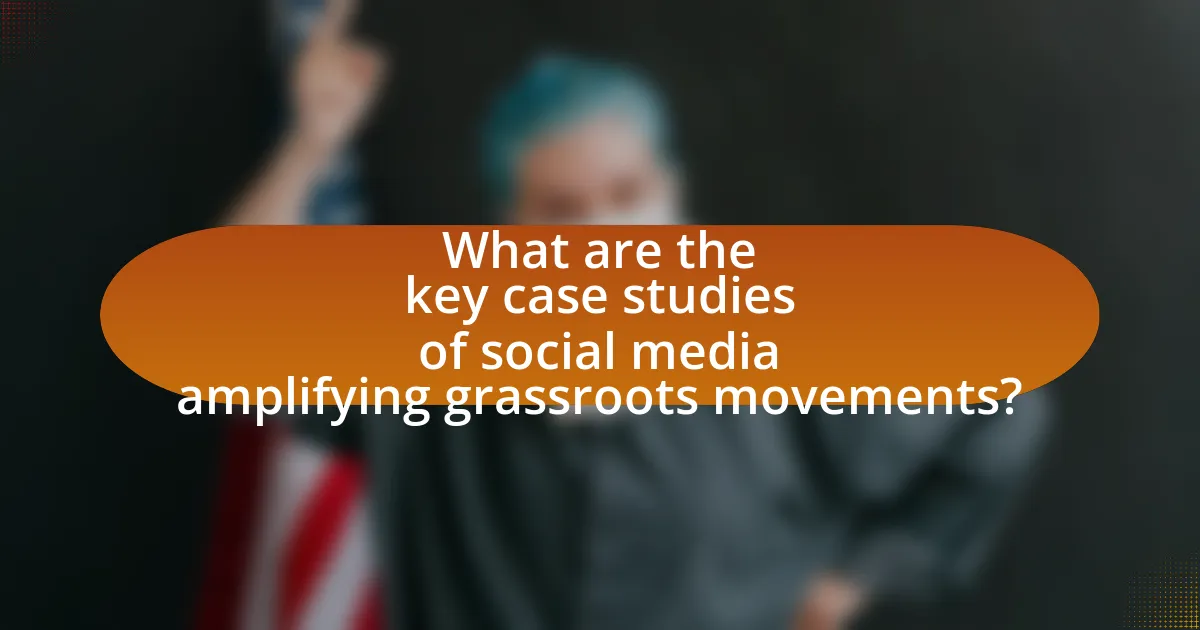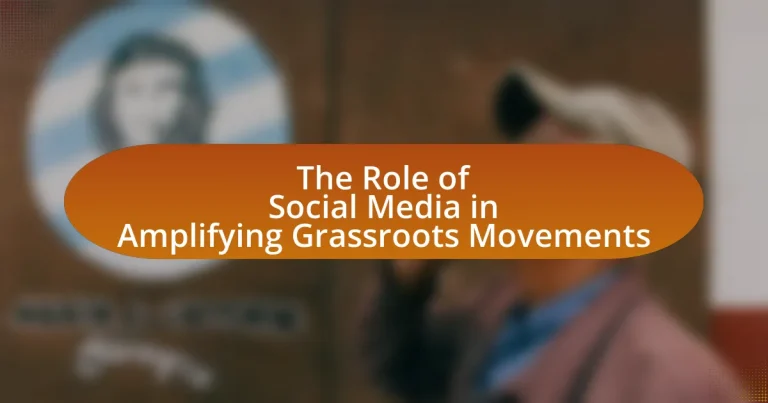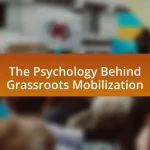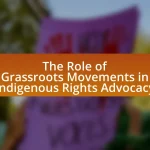The article examines the significant role of social media in amplifying grassroots movements, highlighting its capacity for rapid communication, mobilization, and community building. It discusses how platforms like Facebook, Twitter, and Instagram facilitate grassroots initiatives by enabling quick information dissemination and engagement with diverse audiences. Key case studies, including the Black Lives Matter movement and the Arab Spring, illustrate the effectiveness of social media in organizing protests and raising awareness. Additionally, the article addresses challenges such as misinformation, censorship, and algorithmic bias that grassroots movements face on these platforms, while also providing strategies for effective social media utilization to maximize outreach and impact.

What is the Role of Social Media in Amplifying Grassroots Movements?
Social media plays a crucial role in amplifying grassroots movements by providing a platform for rapid communication, mobilization, and community building. It enables activists to share information, organize events, and rally support on a global scale, often leading to increased visibility and engagement. For instance, the Black Lives Matter movement gained significant traction through social media platforms, where hashtags like #BlackLivesMatter facilitated widespread awareness and participation in protests. Research indicates that social media can enhance civic engagement, with a study by the Pew Research Center showing that 69% of adults in the U.S. use social media, making it a powerful tool for grassroots organizations to reach and influence large audiences effectively.
How does social media facilitate grassroots movements?
Social media facilitates grassroots movements by providing a platform for rapid communication and mobilization among individuals with shared interests. This immediacy allows grassroots organizations to disseminate information quickly, organize events, and rally support on a large scale. For instance, the Arab Spring demonstrated how platforms like Twitter and Facebook enabled activists to coordinate protests and share real-time updates, leading to significant political changes in several countries. Additionally, social media’s ability to reach diverse audiences amplifies messages, as seen in movements like Black Lives Matter, which gained international attention and support through viral posts and hashtags.
What platforms are most effective for grassroots mobilization?
Social media platforms such as Facebook, Twitter, and Instagram are most effective for grassroots mobilization. These platforms enable rapid information dissemination, community building, and engagement with a broad audience. For instance, Facebook’s group feature allows users to create dedicated spaces for organizing events and discussions, while Twitter’s hashtag functionality facilitates trending topics that can amplify messages quickly. Research by the Pew Research Center indicates that 69% of adults in the U.S. use Facebook, making it a crucial tool for reaching diverse demographics. Additionally, a study published in the journal “Social Movement Studies” highlights that Twitter has been instrumental in mobilizing protests, as seen during the Arab Spring, where tweets played a significant role in coordinating actions.
How do social media algorithms impact visibility for grassroots initiatives?
Social media algorithms significantly impact the visibility of grassroots initiatives by determining which content is prioritized in users’ feeds. These algorithms often favor posts that generate high engagement, such as likes, shares, and comments, which can either amplify or suppress grassroots messages based on their ability to resonate with audiences. For instance, a study by the Pew Research Center found that 64% of Americans believe social media has a major impact on political activism, indicating that effective engagement can lead to increased visibility for grassroots movements. Consequently, grassroots initiatives that utilize engaging content and foster community interaction are more likely to be seen and shared, enhancing their reach and influence.
Why is social media crucial for grassroots movements?
Social media is crucial for grassroots movements because it enables rapid communication and mobilization among supporters. This platform allows grassroots organizations to disseminate information quickly, engage with a wider audience, and coordinate actions effectively. For instance, during the Arab Spring, social media played a pivotal role in organizing protests and sharing real-time updates, which significantly contributed to the movements’ visibility and impact. Additionally, studies show that social media can increase participation rates by up to 50%, demonstrating its effectiveness in rallying support and fostering community engagement.
What advantages does social media provide over traditional media?
Social media provides real-time communication and broader reach compared to traditional media. Unlike traditional media, which often has delayed reporting and limited audience engagement, social media allows for instantaneous sharing of information and direct interaction between users. For instance, during grassroots movements, platforms like Twitter and Facebook enable activists to mobilize support quickly, as seen in the Arab Spring, where social media played a crucial role in organizing protests and disseminating information rapidly. This immediacy and interactivity empower grassroots movements to gain visibility and support more effectively than traditional media channels.
How does social media enhance community engagement and participation?
Social media enhances community engagement and participation by providing platforms for real-time communication and interaction among community members. These platforms facilitate the sharing of information, mobilization of resources, and organization of events, which fosters a sense of belonging and collective action. For instance, studies show that 70% of social media users engage with local community issues through these platforms, leading to increased awareness and participation in community initiatives. Additionally, social media allows for diverse voices to be heard, enabling marginalized groups to advocate for their needs and interests, thus strengthening community ties and involvement.
What challenges do grassroots movements face on social media?
Grassroots movements face significant challenges on social media, including algorithmic bias, misinformation, and platform censorship. Algorithmic bias can limit the visibility of grassroots content, as social media platforms often prioritize mainstream narratives over smaller movements. Misinformation can undermine the credibility of grassroots initiatives, as false narratives can spread rapidly, overshadowing authentic messages. Additionally, platform censorship can lead to the removal of content deemed inappropriate or harmful, which disproportionately affects grassroots movements that may challenge established norms. These challenges hinder the ability of grassroots movements to effectively mobilize support and disseminate their messages.
How do misinformation and disinformation affect grassroots campaigns?
Misinformation and disinformation significantly undermine grassroots campaigns by eroding trust and distorting public perception. Grassroots movements rely on community engagement and credibility; when false information circulates, it can mislead supporters and create divisions within the community. For instance, a study by the Pew Research Center found that 64% of Americans believe that misinformation has a major impact on public opinion, which can lead to decreased participation in grassroots initiatives. Additionally, disinformation campaigns can divert resources and attention away from legitimate issues, ultimately hindering the effectiveness of grassroots efforts.
What are the risks of censorship and platform policies for grassroots movements?
Censorship and platform policies pose significant risks to grassroots movements by limiting their ability to communicate, organize, and mobilize effectively. When social media platforms enforce strict content moderation or censorship, they can suppress critical messages, stifle dissent, and hinder the visibility of grassroots initiatives. For instance, during the Black Lives Matter protests in 2020, many activists reported that their posts were removed or flagged, which directly impacted their outreach efforts. Additionally, algorithm changes can prioritize mainstream narratives over grassroots content, further marginalizing these movements. This suppression can lead to decreased public awareness and support, ultimately undermining the goals of grassroots organizations.
How can grassroots movements effectively utilize social media?
Grassroots movements can effectively utilize social media by creating targeted campaigns that engage their audience and foster community involvement. By leveraging platforms like Facebook, Twitter, and Instagram, these movements can disseminate information rapidly, mobilize supporters, and amplify their message to a wider audience. For instance, the Black Lives Matter movement utilized social media to organize protests and share real-time updates, resulting in increased visibility and support, as evidenced by a 2020 Pew Research study showing that 53% of U.S. adults reported learning about the movement through social media. This demonstrates that strategic use of social media can enhance outreach and engagement for grassroots initiatives.
What strategies can be employed to maximize outreach on social media?
To maximize outreach on social media, organizations should employ targeted content creation, strategic timing, and engagement tactics. Targeted content creation involves crafting messages that resonate with specific audience segments, which can increase relevance and shareability. For instance, using data from Pew Research Center indicates that 69% of adults in the U.S. use Facebook, suggesting that tailored content for this platform can significantly enhance visibility.
Strategic timing refers to posting during peak engagement hours, which varies by platform; studies show that posts made on weekdays between 1 PM and 3 PM generally receive higher interaction rates. Engagement tactics, such as responding to comments and encouraging user-generated content, foster community and loyalty, leading to organic sharing and broader reach. Research from Sprout Social highlights that brands that actively engage with their audience see a 20-40% increase in overall engagement.
By combining these strategies, organizations can effectively amplify their outreach on social media platforms.
How can grassroots movements measure their social media impact?
Grassroots movements can measure their social media impact by analyzing engagement metrics such as likes, shares, comments, and follower growth. These metrics provide quantitative data that reflects the reach and resonance of their messages. For instance, a study by the Pew Research Center found that social media platforms significantly amplify the visibility of grassroots campaigns, with 69% of adults in the U.S. using social media to engage with social issues. Additionally, tracking the use of specific hashtags can help movements assess the spread of their messages and the level of public discourse generated around their causes.

What are the key case studies of social media amplifying grassroots movements?
Key case studies of social media amplifying grassroots movements include the Arab Spring, Black Lives Matter, and the #MeToo movement. The Arab Spring, which began in 2010, utilized platforms like Facebook and Twitter to organize protests against authoritarian regimes, leading to significant political changes in countries like Tunisia and Egypt. Black Lives Matter, founded in 2013, leveraged social media to raise awareness about police brutality and systemic racism, mobilizing millions for protests and influencing policy discussions. The #MeToo movement, which gained traction in 2017, used social media to empower individuals to share their experiences of sexual harassment and assault, resulting in widespread societal and legislative changes. These examples demonstrate how social media serves as a powerful tool for grassroots mobilization and advocacy.
How did social media influence the Arab Spring?
Social media significantly influenced the Arab Spring by facilitating rapid communication and mobilization among protesters. Platforms like Facebook and Twitter enabled activists to organize demonstrations, share information, and disseminate real-time updates, which helped to amplify grassroots movements across multiple countries. For instance, in Tunisia, social media played a crucial role in the coordination of protests that ultimately led to the ousting of President Zine El Abidine Ben Ali in January 2011. Additionally, the use of social media allowed for the documentation of events, which garnered international attention and support, further energizing the movements in Egypt, Libya, and Syria. The ability to bypass state-controlled media and communicate directly with the public was instrumental in shaping the narrative and sustaining momentum during the uprisings.
What role did specific platforms play in organizing protests?
Specific platforms played a crucial role in organizing protests by facilitating communication, mobilization, and coordination among activists. Social media platforms like Twitter, Facebook, and Instagram enabled users to share information rapidly, create event pages, and disseminate calls to action, which significantly increased participation rates. For instance, during the Arab Spring, Twitter was instrumental in organizing protests across multiple countries, allowing activists to coordinate efforts and share real-time updates, which contributed to the success of these movements. Additionally, studies have shown that social media can enhance the visibility of grassroots movements, as seen in the Black Lives Matter protests, where hashtags and viral posts galvanized support and drew international attention.
How did social media shape public perception during the Arab Spring?
Social media significantly shaped public perception during the Arab Spring by facilitating rapid information dissemination and mobilizing grassroots activism. Platforms like Facebook and Twitter enabled individuals to share real-time updates, organize protests, and amplify dissent against authoritarian regimes. For instance, the use of hashtags such as #Jan25 during the Egyptian revolution helped unify diverse groups and draw international attention, leading to widespread support for the movement. Research by the Pew Research Center indicates that social media was instrumental in increasing awareness and engagement among young people, who were pivotal in the protests. This digital connectivity not only altered local perceptions but also influenced global narratives about the uprisings, showcasing the power of social media in shaping political discourse.
What lessons can be learned from the Black Lives Matter movement?
The Black Lives Matter movement teaches the importance of social media as a tool for mobilization and awareness. Social media platforms enabled rapid dissemination of information, allowing grassroots activists to organize protests and share personal stories of racial injustice, which garnered widespread attention. For instance, the hashtag #BlackLivesMatter went viral, leading to global protests and discussions about systemic racism. This demonstrates that social media can amplify marginalized voices and create a sense of community among activists, ultimately influencing public opinion and policy changes.
How did social media campaigns mobilize support and awareness?
Social media campaigns mobilized support and awareness by leveraging platforms to disseminate information rapidly and engage users in real-time discussions. These campaigns utilized targeted messaging, hashtags, and viral content to reach wider audiences, often resulting in increased participation in movements. For instance, the #BlackLivesMatter campaign effectively raised awareness about racial injustice, leading to global protests and policy discussions, as evidenced by a 2020 Pew Research Center study showing that 67% of Americans were aware of the movement and its goals. This demonstrates the significant impact social media has in amplifying grassroots movements and fostering community engagement.
What impact did viral hashtags have on the movement’s visibility?
Viral hashtags significantly increased the visibility of grassroots movements by facilitating widespread engagement and awareness across social media platforms. For instance, the #BlackLivesMatter hashtag led to millions of posts and discussions, amplifying the movement’s reach and drawing global attention to issues of racial injustice. This phenomenon is supported by data indicating that social media campaigns utilizing viral hashtags can generate substantial media coverage and public discourse, as seen during the protests following George Floyd’s death in 2020, where the hashtag trended worldwide, resulting in a surge of participation and support for the movement.
What other notable grassroots movements have utilized social media?
Notable grassroots movements that have utilized social media include the Black Lives Matter movement, which gained significant traction through platforms like Twitter and Instagram to raise awareness about racial injustice and police brutality. Additionally, the Me Too movement leveraged social media to empower individuals to share their experiences with sexual harassment and assault, leading to widespread societal discussions and changes in various industries. The Arab Spring is another example, where social media played a crucial role in organizing protests and disseminating information across the Middle East, ultimately contributing to political upheaval in several countries. These movements demonstrate the power of social media in mobilizing support and fostering community engagement around critical social issues.
How did the #MeToo movement leverage social media for awareness?
The #MeToo movement leveraged social media to raise awareness by creating a platform for individuals to share their personal experiences with sexual harassment and assault. This widespread sharing on platforms like Twitter and Facebook allowed for rapid dissemination of stories, fostering a sense of community and solidarity among survivors. The hashtag #MeToo became a rallying cry, trending globally and prompting discussions about systemic issues related to gender-based violence. According to a study published in the journal “Communication Research,” the movement’s use of social media significantly increased public engagement and visibility, with millions of posts contributing to a cultural shift in how society addresses these issues.
What strategies were effective in the climate change activism movement?
Effective strategies in the climate change activism movement include leveraging social media for awareness, organizing grassroots campaigns, and engaging in direct action. Social media platforms like Twitter and Instagram have been instrumental in spreading information rapidly, mobilizing supporters, and creating viral campaigns, such as the #FridaysForFuture movement initiated by Greta Thunberg, which inspired millions globally to participate in climate strikes. Grassroots campaigns have effectively localized issues, allowing communities to address specific environmental concerns while fostering a sense of collective action. Direct action, including protests and sit-ins, has drawn significant media attention, pressuring policymakers to prioritize climate action. These strategies collectively enhance visibility and urgency around climate issues, demonstrating their effectiveness in the activism movement.

What future trends can we expect in the role of social media for grassroots movements?
Future trends in the role of social media for grassroots movements include increased use of video content, enhanced data analytics for targeted outreach, and the rise of decentralized platforms. Video content is projected to dominate social media, as platforms like TikTok and Instagram prioritize short-form videos, allowing grassroots movements to convey messages quickly and engagingly. Enhanced data analytics will enable organizers to identify and reach specific demographics more effectively, improving engagement and mobilization efforts. Additionally, decentralized platforms, which prioritize user privacy and reduce censorship, are expected to gain traction, providing grassroots movements with alternative spaces to organize and communicate without the constraints of traditional social media. These trends are supported by the growing preference for visual content among younger audiences and the increasing concerns over data privacy and platform control.
How might emerging technologies impact grassroots mobilization?
Emerging technologies significantly enhance grassroots mobilization by facilitating communication, organizing efforts, and increasing outreach. For instance, social media platforms enable rapid dissemination of information, allowing grassroots movements to quickly mobilize supporters and coordinate actions. According to a study by the Pew Research Center, 69% of adults in the U.S. use social media, which provides a vast audience for grassroots campaigns to engage with. Additionally, tools like crowdfunding platforms allow grassroots organizations to raise funds efficiently, further empowering their initiatives. The integration of data analytics also enables these movements to target specific demographics, optimizing their strategies for greater impact.
What role will artificial intelligence play in social media strategies?
Artificial intelligence will play a crucial role in enhancing social media strategies by enabling data-driven decision-making and personalized content delivery. AI algorithms analyze vast amounts of user data to identify trends, preferences, and behaviors, allowing brands to tailor their messaging effectively. For instance, a study by McKinsey & Company found that companies using AI in their marketing strategies can increase their productivity by up to 40%. Additionally, AI-powered tools can automate content creation and scheduling, optimize ad targeting, and improve customer engagement through chatbots, thereby streamlining operations and maximizing outreach.
How can virtual reality enhance grassroots engagement?
Virtual reality can enhance grassroots engagement by providing immersive experiences that foster emotional connections and understanding among participants. This technology allows individuals to experience scenarios and environments related to social issues firsthand, which can lead to increased empathy and motivation to act. For instance, studies have shown that virtual reality simulations of climate change impacts can significantly raise awareness and inspire community action, as participants can visualize the consequences in a compelling way. By creating shared experiences, virtual reality can mobilize grassroots movements more effectively than traditional media, as it engages users on a deeper emotional level, leading to higher levels of participation and advocacy.
What are the implications of changing social media policies for grassroots movements?
Changing social media policies significantly impacts grassroots movements by altering their ability to organize, communicate, and mobilize supporters. For instance, stricter content moderation can limit the visibility of grassroots campaigns, as seen during the 2020 U.S. elections when platforms like Facebook and Twitter implemented new rules that affected political advertising and messaging. This can lead to reduced engagement and outreach, hindering the movement’s growth and effectiveness. Additionally, changes in algorithms can prioritize mainstream narratives over grassroots initiatives, further marginalizing these movements. Historical examples, such as the Arab Spring, demonstrate how social media policies can either empower or suppress grassroots activism, highlighting the critical role these platforms play in shaping public discourse and mobilization efforts.
How might increased regulation affect grassroots advocacy?
Increased regulation may hinder grassroots advocacy by imposing restrictions on funding, communication, and mobilization efforts. For instance, regulations that limit campaign contributions or require extensive reporting can reduce the financial resources available to grassroots organizations, making it difficult for them to sustain their activities. Additionally, stricter rules on social media advertising and data privacy can limit the ability of these groups to effectively reach and engage their target audiences. Research from the Brennan Center for Justice indicates that such regulations can disproportionately impact smaller organizations that lack the infrastructure to comply with complex legal requirements, ultimately stifling their ability to influence public policy and mobilize supporters.
What strategies can grassroots movements adopt to adapt to policy changes?
Grassroots movements can adopt several strategies to adapt to policy changes, including leveraging social media for real-time communication and mobilization. By utilizing platforms like Twitter and Facebook, these movements can quickly disseminate information about policy shifts, engage supporters, and coordinate responses. For instance, during the 2017 Women’s March, organizers effectively used social media to rally participants and share updates, demonstrating the power of digital platforms in facilitating grassroots activism. Additionally, grassroots movements can build coalitions with other organizations to strengthen their advocacy efforts and amplify their voices in response to policy changes. This collaborative approach can enhance their influence and reach, as seen in various environmental movements that unite diverse groups to address climate policy.
What best practices should grassroots movements follow on social media?
Grassroots movements should prioritize authenticity, engagement, and strategic content sharing on social media. Authenticity builds trust and credibility, as movements that share genuine stories and experiences resonate more with audiences. Engagement is crucial; responding to comments, participating in discussions, and encouraging user-generated content fosters a sense of community and involvement. Strategic content sharing involves using data analytics to identify peak engagement times and tailoring messages to specific platforms, ensuring that the content reaches the intended audience effectively. For instance, a study by the Pew Research Center indicates that 69% of adults in the U.S. use social media, highlighting its potential reach for grassroots initiatives.
How can movements create compelling content that resonates with audiences?
Movements can create compelling content that resonates with audiences by leveraging authentic storytelling and emotional engagement. Authentic storytelling allows movements to share personal narratives that reflect the experiences and struggles of individuals, fostering a sense of connection and empathy among audiences. Emotional engagement is crucial, as content that evokes strong feelings—such as hope, anger, or solidarity—tends to be more memorable and shareable. For instance, the #MeToo movement utilized personal testimonies to highlight the prevalence of sexual harassment, which resonated widely and led to increased awareness and action. This approach not only amplifies the message but also encourages community participation and support, making the content more impactful.
What are effective ways to build and maintain an online community?
Effective ways to build and maintain an online community include fostering engagement through regular interaction, creating valuable content, and establishing clear guidelines. Engaging with community members through comments, polls, and discussions encourages participation and strengthens relationships. Providing valuable content, such as informative articles or resources, keeps members interested and invested in the community. Establishing clear guidelines helps maintain a respectful and inclusive environment, which is essential for long-term sustainability. Research indicates that communities with active moderation and clear rules experience higher retention rates and member satisfaction, as seen in studies conducted by the Pew Research Center on online community dynamics.


